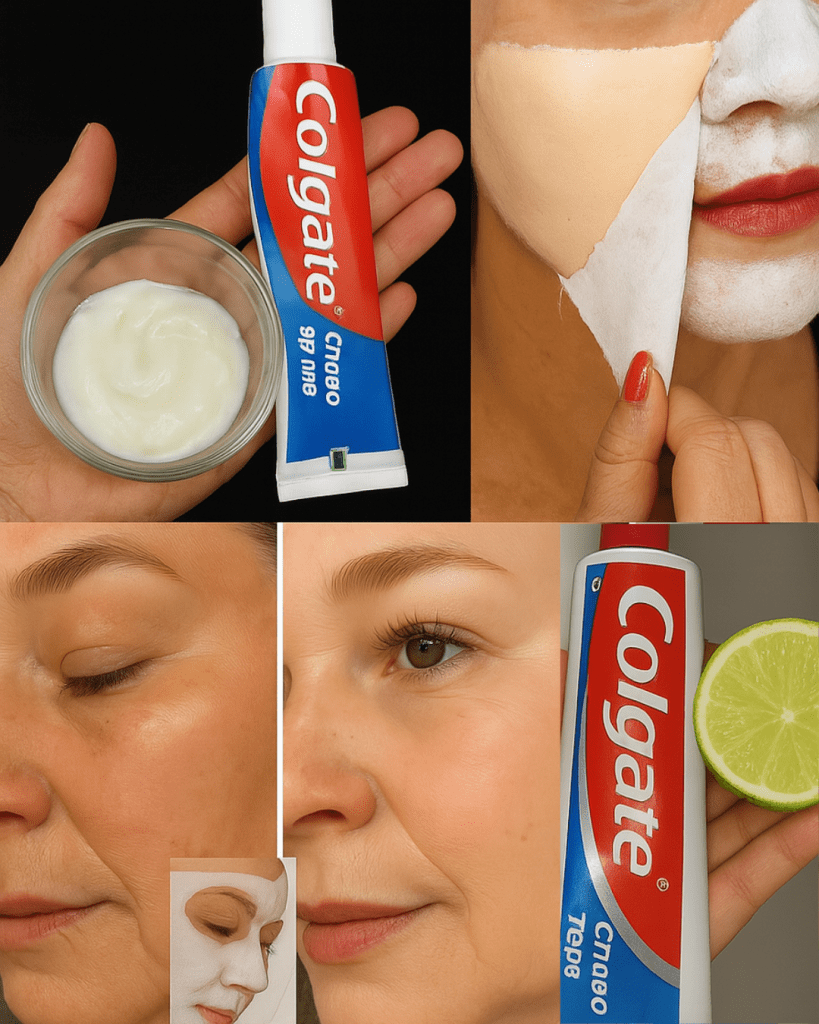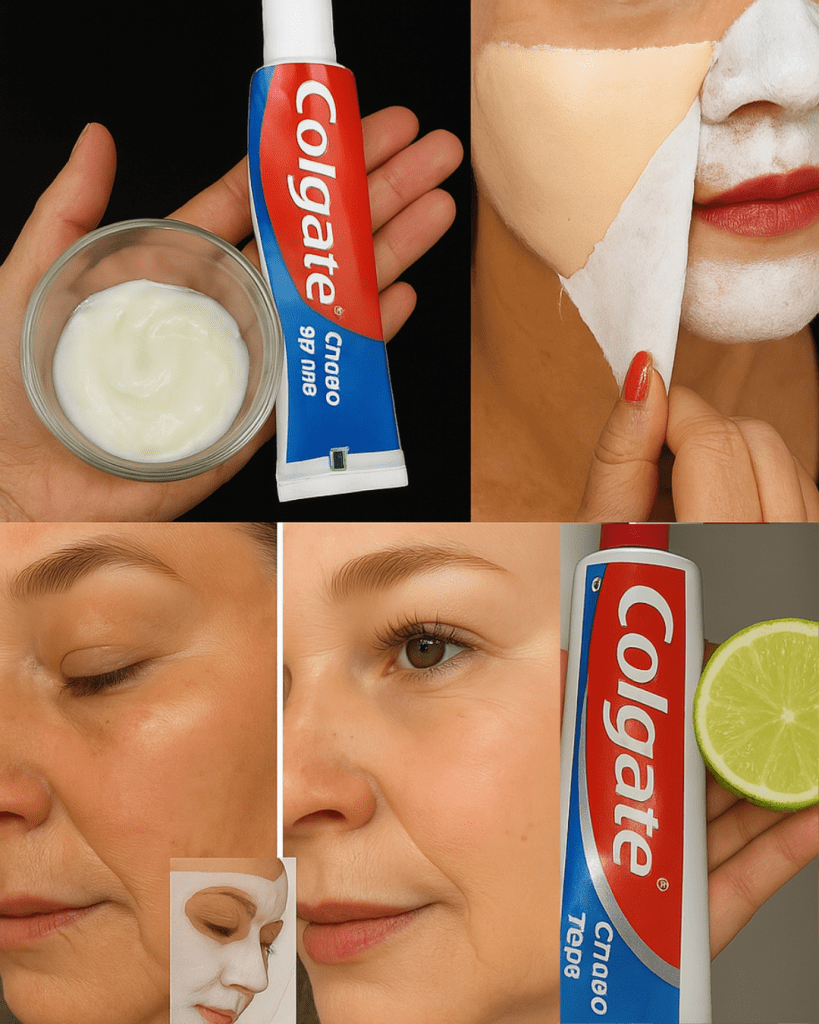What if the secret to radiant, brighter skin was hiding in your bathroom and kitchen? The viral trend of mixing Colgate toothpaste with lemon juice promises a dazzling complexion on a budget, captivating skincare enthusiasts across America. But before you slather this quirky combo on your face, pause—could this social media sensation be too good to be true? Dive into the truth behind this DIY hack, backed by dermatological insights, to discover whether it’s a glow-up game-changer or a risky misstep. Get ready for a revealing journey that’ll empower you to care for your skin smarter and safer.

What’s the Buzz About Colgate and Lemon?
The Colgate toothpaste and lemon trend has taken social media by storm, with claims that this DIY face mask or scrub can lighten dark spots, even skin tone, and deliver a luminous glow. The method is simple: mix a dab of Colgate toothpaste with fresh lemon juice, apply it to your face, let it sit for 10–20 minutes, and rinse off. Advocates swear by its ability to whiten skin with regular use, fueled by Colgate’s teeth-whitening reputation and lemon’s natural acidity. But dermatologists urge caution—what works for your smile may wreak havoc on your skin. Let’s unpack why this trend is so tempting and where it falls short.
🌟 Budget-Friendly Appeal
With toothpaste and lemons costing mere pennies, this hack feels like a steal compared to pricey serums.
⏱️ Quick and Easy
No fancy tools or skills needed—just mix, apply, and rinse for a spa-like ritual at home.
🍋 Natural Allure
Lemon’s vitamin C and Colgate’s trusted branding give the combo a wholesome, safe vibe.
💫 Cultural Draw
In many cultures, lighter skin is prized, driving curiosity for affordable brightening solutions.
Despite its allure, the science tells a different story. Let’s explore why this viral remedy might do more harm than good.
🔬 The Science: Why Toothpaste and Lemon Don’t Mix for Skin
Can a toothpaste designed for teeth and a citrus fruit really transform your complexion? Dermatological experts say no—and here’s why this combo could spell trouble for your skin.
Colgate Toothpaste: A Dental Hero, Not a Skin Savior
Colgate toothpaste, whether it’s Optic White or Active Salt Lemon, is engineered to polish teeth with mild abrasives, sodium lauryl sulfate, and fluoride. These ingredients are far too harsh for delicate facial skin.
- Irritation Risk: Toothpaste’s alkaline pH disrupts the skin’s natural acidic barrier, leading to redness, burning, or dryness.
- Abrasive Damage: Its gritty texture can micro-tear skin, causing inflammation or peeling.
- No Brightening Proof: There’s zero scientific evidence that toothpaste whitens skin, and its strong detergents may trigger allergic reactions like contact dermatitis.
Lemon Juice: Bright but Risky
Lemon juice boasts vitamin C and citric acid, which can mildly reduce melanin for a brighter look. But its benefits come with serious caveats.
- Acidic Overload: Lemon’s low pH irritates the skin, weakening its protective barrier and causing sensitivity.
- Sun-Sensitive Reactions: Citric acid increases photosensitivity, risking phytophotodermatitis—painful burns or dark patches when exposed to sunlight.
- Inconsistent Results: Lemon’s potency varies, making it unreliable for safe, controlled brightening.
The Combo: A Recipe for Trouble
Mixing Colgate and lemon doesn’t amplify their effects—it compounds their risks. The abrasive toothpaste paired with lemon’s acidity creates a harsh concoction that can strip moisture, inflame skin, and lead to long-term damage, especially for sensitive types. Dermatological reviews confirm no studies support this blend for skin whitening, and experts warn against its use due to potential for irritation and scarring.
🚫 Why This DIY Trend Falls Flat
The Colgate and lemon hack thrives on social media hype, but its promises crumble under scrutiny. Here’s why it’s a skincare misstep:
🔥 Harsh on Skin: The combo’s abrasive and acidic nature can disrupt your skin’s balance, leading to redness, peeling, or burns.
🚫 No Proven Benefits: Despite bold claims, no research backs this mixture for brightening or whitening skin.
🩺 Risk for Sensitive Skin: Those with eczema, rosacea, or dry skin are especially prone to adverse reactions.
📸 Misleading Hype: Social media before-and-afters often exaggerate results or rely on lighting tricks, not science.
Instead of gambling with your skin, let’s explore safer, dermatologist-approved ways to achieve that coveted glow.
🌿 Safer Paths to Radiant Skin
Skip the risky DIY experiments and embrace these evidence-based strategies for a brighter, healthier complexion. These methods are gentle, effective, and designed to nurture your skin long-term.
💧 Vitamin C Serums
Opt for a stable, skin-safe vitamin C serum (10–20% concentration) to fade dark spots and boost radiance. Apply daily under sunscreen for best results. These are formulated to brighten without irritation.
🧴 Daily Sunscreen
A broad-spectrum SPF 30+ is your skin’s best defense against UV damage, which causes dark spots and dullness. Apply every morning, even on cloudy days, to maintain an even tone.
🌸 Gentle Exfoliation
Use a chemical exfoliant with alpha-hydroxy acids (AHAs) or beta-hydroxy acids (BHAs) 1–2 times weekly to slough off dead skin cells, revealing a smoother, brighter surface. Avoid harsh physical scrubs.
🥗 Antioxidant-Rich Diet
Fuel your skin from within with foods like berries, spinach, and walnuts, packed with vitamins A, C, and E. These nutrients support collagen production and protect against oxidative stress.
💦 Stay Hydrated
Drink 8–10 cups of water daily to keep your skin plump, hydrated, and naturally glowing. Pair with hydrating foods like cucumber or watermelon for an extra boost.
Quick Glow-Boosting Routine:
- Morning: Cleanse, apply vitamin C serum, moisturize, and finish with SPF 30+.
- Evening: Cleanse, use a gentle exfoliant (2x weekly), and moisturize.
- Daily: Eat colorful fruits and veggies, and sip water consistently.
These habits deliver lasting radiance without compromising your skin’s health.
🩹 What to Do If You’ve Tried the Combo
If you’ve already applied the Colgate and lemon mixture and are experiencing irritation, redness, or discomfort, act quickly to soothe your skin and prevent further damage.
🚿 Stop Immediately: Discontinue use to avoid worsening irritation.
🧼 Rinse Thoroughly: Wash your face with lukewarm water and a fragrance-free, gentle cleanser to remove all traces of the mixture.
🧴 Moisturize Intensely: Apply a hypoallergenic moisturizer with ceramides, hyaluronic acid, or aloe vera to restore your skin’s barrier.
☀️ Shield from Sun: Use SPF 30+ and avoid direct sunlight to protect sensitive skin from UV damage. Wear a wide-brimmed hat for extra coverage.
🩺 Seek Expert Help: If redness, burning, or peeling persists beyond 48 hours, consult a dermatologist for tailored treatment, such as a mild corticosteroid cream.
Prompt action can help your skin recover and minimize long-term effects.
⚠️ The Dangers of DIY Skincare Trends
The Colgate and lemon trend is just one of many DIY skincare hacks fueled by social media’s allure of instant results. But these viral remedies often lack scientific grounding and can lead to serious consequences.
📱 Social Media Misleads: Before-and-after photos may be edited or staged, creating false expectations.
🧪 Wrong Ingredients: Products like toothpaste are formulated for specific purposes, not universal use. Applying them to skin ignores their chemical makeup.
🩹 Hidden Risks: Harsh ingredients can cause burns, scarring, or hyperpigmentation, especially for darker skin tones.
💡 Expert Advice Matters: Dermatologists advocate for products designed for skin, tested for safety, and backed by research.
Before trying any viral hack, verify claims with credible sources and prioritize skin-safe alternatives.

🧼 Build a Simple, Effective Skincare Routine
Ditch the quick fixes and invest in a sustainable routine that nurtures your skin daily. This dermatologist-approved plan is affordable, beginner-friendly, and safe for all skin types.
🧴 Cleanse Gently
Use a pH-balanced, fragrance-free cleanser twice daily to remove dirt and oil without stripping your skin’s natural moisture.
💦 Moisturize Daily
Apply a lightweight, non-comedogenic moisturizer morning and night to lock in hydration and strengthen your skin barrier.
☀️ Protect with SPF
Every morning, apply a broad-spectrum SPF 30+ to shield against UV rays, preventing dark spots and premature aging.
🌟 Treat Targeted Concerns
Incorporate a vitamin C serum or retinoid (2–3 times weekly, at night) to address dullness or uneven tone. Start slowly to avoid irritation.
🥕 Nourish from Within
Eat a balanced diet with fruits, vegetables, lean proteins, and healthy fats to supply your skin with essential nutrients.
This routine is your foundation for glowing, healthy skin that lasts.
✨ Glow Smart, Not Risky
The Colgate toothpaste and lemon trend may promise a brighter complexion, but its risks far outweigh any unproven benefits. Harsh ingredients and acidic properties make this DIY hack a recipe for irritation, burns, or long-term damage. Instead, embrace dermatologist-backed solutions like vitamin C serums, daily sunscreen, and a nutrient-rich diet to achieve radiant skin safely. Your complexion deserves care that’s gentle, effective, and rooted in science—so skip the toothpaste and lemon, and glow with confidence.
Ready to elevate your skincare game? Try one of these safe brightening tips today and share your favorite glow-up secret in the comments below. Let’s inspire each other to shine naturally!
This content is for informational purposes only and is not a substitute for professional medical advice. Always consult a dermatologist before making changes to your skincare routine.









